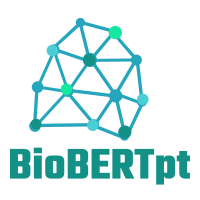🚀 Portuguese Clinical NER - Finding
The Finding NER model is part of the BioBERTpt project, which aims to train models for clinical entity recognition in Portuguese.
This Finding NER model is a component of the BioBERTpt project. In this project, 13 models for clinical entities (compatible with UMLS) were trained. All NER models from the "pucpr" user were trained using the Brazilian clinical corpus SemClinBr. The training was carried out for 10 epochs in the IOB2 format, starting from the BioBERTpt(all) model.
Widget
- "RECEBE ALTA EM BOM ESTADO GERAL, COM PLANO DE ACOMPANHAR NO AMBULATÓRIO."
- "PACIENTE APRESENTOU BOA EVOLUÇÃO CLÍNICA APÓS OTIMIZAÇÃO DO TTO DA ICC."
Datasets
Thumbnail

📚 Documentation
Acknowledgements
This study was partially funded by the Coordenação de Aperfeiçoamento de Pessoal de Nível Superior - Brasil (CAPES) - Finance Code 001.
Citation
@inproceedings{schneider-etal-2020-biobertpt,
title = "{B}io{BERT}pt - A {P}ortuguese Neural Language Model for Clinical Named Entity Recognition",
author = "Schneider, Elisa Terumi Rubel and
de Souza, Jo{\~a}o Vitor Andrioli and
Knafou, Julien and
Oliveira, Lucas Emanuel Silva e and
Copara, Jenny and
Gumiel, Yohan Bonescki and
Oliveira, Lucas Ferro Antunes de and
Paraiso, Emerson Cabrera and
Teodoro, Douglas and
Barra, Cl{\'a}udia Maria Cabral Moro",
booktitle = "Proceedings of the 3rd Clinical Natural Language Processing Workshop",
month = nov,
year = "2020",
address = "Online",
publisher = "Association for Computational Linguistics",
url = "https://www.aclweb.org/anthology/2020.clinicalnlp-1.7",
pages = "65--72",
abstract = "With the growing number of electronic health record data, clinical NLP tasks have become increasingly relevant to unlock valuable information from unstructured clinical text. Although the performance of downstream NLP tasks, such as named-entity recognition (NER), in English corpus has recently improved by contextualised language models, less research is available for clinical texts in low resource languages. Our goal is to assess a deep contextual embedding model for Portuguese, so called BioBERTpt, to support clinical and biomedical NER. We transfer learned information encoded in a multilingual-BERT model to a corpora of clinical narratives and biomedical-scientific papers in Brazilian Portuguese. To evaluate the performance of BioBERTpt, we ran NER experiments on two annotated corpora containing clinical narratives and compared the results with existing BERT models. Our in-domain model outperformed the baseline model in F1-score by 2.72{\%}, achieving higher performance in 11 out of 13 assessed entities. We demonstrate that enriching contextual embedding models with domain literature can play an important role in improving performance for specific NLP tasks. The transfer learning process enhanced the Portuguese biomedical NER model by reducing the necessity of labeled data and the demand for retraining a whole new model.",
}
Questions?
If you have any questions, please post a Github issue on the BioBERTpt repo.

